Few issues strike fear into the hearts of payroll professionals like trying to calculate overtime pay, especially given the challenges associated with determining the “regular rate of pay,” which serves as the foundation for the calculation of overtime pay for non-exempt, hourly employees. On Monday, March 5, 2018, the California Supreme Court ruled in favor of Hector Alvarado, Plaintiff/Appellant in Alvarado v. Dart Container Corporation of California, providing much needed clarity to employers on how to calculate the regular rate of pay during a payroll period that includes the payment of a flat sum, non-hourly paid bonus (the “Bonus”). The question at issue before the California Supreme Court was one of policy expressed through mathematics: What is the divisor (number to divide total compensation by) for purposes of calculating the hourly value of a flat sum, non-hourly paid bonus; is it all hours worked, or only non-overtime hours worked during the relevant pay period? The California Supreme Court decided that it is the latter, resulting in a higher “regular rate of pay” and hence, a higher premium for overtime pay.
Mr. Alvarado worked for Respondent Dart Container Corporation of California (“Dart”) in Dart’s warehouse for approximately 16 months. Dart provided an attendance bonus of $15 per day to any employee who was scheduled to work a weekend shift and completed the full shift. Whether the employee worked overtime or not, they received the bonus for completing a Saturday or Sunday shift. In Mr. Alvarado’s case, sometimes he worked the weekend shift plus overtime during that pay period (entitling him to the attendance bonus), and sometimes he did not work overtime. While both parties agreed that the flat sum, non-hourly bonus at issue was properly a factor in calculating the regular rate of pay (and the corresponding overtime payment), Mr. Alvarado took the position, consistent with California’s Division of Labor Standards Enforcement (“DLSE”), that the correct formula for calculating overtime pay was Bonus divided by all non-overtime hours worked. Conversely, Respondent Dart Container Corporation (“Dart”) argued, in line with the federal Fair Labor Standards Act (“FLSA”), that the proper overtime calculation was Bonus divided by the total hours worked in that pay period, inclusive of both regular and overtime hours. Not surprisingly, Alvarado’s proposed formula results in a higher payment for overtime than Dart’s interpretation.
In its opinion, the court first addressed whether or not the DLSE guidance contained in its Manual is controlling, or is a void underground regulation. The court concluded that the DLSE guidance was void because it was not promulgated pursuant to the formal rule-making process required by California’s Administrative Procedures Act, and was more than a mere restatement of the law. Nevertheless, the court noted that the DLSE’s interpretation of state law may still be correct. Despite finding that the DLSE guidance was not entitled to deference, the court opined that it was free to consider the DLSE’s interpretation, including the reasons for the DLSE’s interpretation, and could even choose to adopt the DLSE’s interpretation, provided that the Court was persuaded that the DLSE was correct. “As an underground regulation, the DLSE’s policy is not entitled to any special deference … but the interpretation embodied in that policy may still be valid,” wrote Justice Chin for a unanimous court.
Anchoring their reasoning in two overarching interpretive principles — (1) California’s stated public policy discouraging employers from requiring employees to work overtime (which the overtime premium is intended to do), and (2) the court’s policy of interpreting employment legislation liberally to protect workers — the court held that because Alvarado was entitled to the Bonus even if he worked no overtime during the relevant pay period, it should be treated as having been earned by virtue of the non-overtime hours he worked during the pay period. Accordingly, when calculating the per-hour value of a flat sum, non-hourly paid bonus, the court ruled that the proper formula for determining the regular rate of pay is: Bonus divided by non-overtime hours worked. Notably, the court expressly limited its decision to flat-sum bonuses like the attendance bonuses at issue, as opposed to other kinds of non-hourly compensation, such as production bonuses, piecework bonuses, and commissions, where an alternative analysis may be warranted.
Adding insult to injury, the court decided that this ruling applies retroactively, rather than limiting the application of its decision to pending and future cases. Practically speaking, this puts all employers who provide these kinds of flat sum, non-hourly bonuses at risk of substantial exposure for back wages, pay stub errors, and, in the case of former employees, waiting time penalties for failing to promptly pay the proper final paycheck, among others. Moreover, based on this holding, employers that have miscalculated the proper overtime in these circumstances are prime targets for class action litigation.
In what can only be described as “cold comfort,” four of the Justices took the unusual step of signing on to a brief concurring opinion, stating, “[r]egrettably, more was not done to help employers meet their statutory responsibilities, or to ensure that employees receive the overtime pay they are due.” So, as California employers review their overtime pay practices for the last 3-4 years (depending on whether a claim is brought directly under the Labor Code, or is brought as an unfair labor practice) to assess their risk of liability, they can take comfort in knowing that the California Supreme Court finds it “regrettable.”



 i
i

